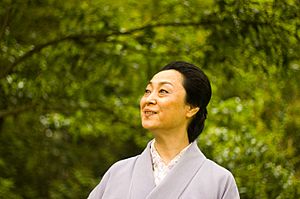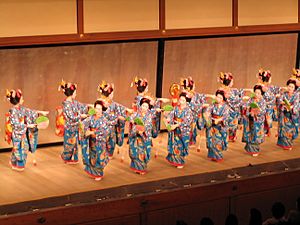Mineko Iwasaki facts for kids
Quick facts for kids
Mineko Iwasaki
|
|
|---|---|
| 岩崎 峰子 | |
 |
|
| Born |
Masako Tanaka
November 2, 1949 |
| Spouse(s) |
Jinichiro Iwasaki (née Sato)
(m. 1964; died 2009) |
| Children | Kosuke (born 1983) |
Mineko Iwasaki (岩崎 峰子/岩崎 究香, Iwasaki Mineko, born Masako Tanaka (田中 政子), 2 November 1949) is a Japanese businesswoman, author, and former geisha. She was once the most famous geisha in Japan. She retired suddenly at the age of 29. Mineko Iwasaki was known for her performances for important people and even royalty during her time as a geisha. She was also chosen to be the future leader (called atotori) of her geisha house (okiya) when she was just a young apprentice.
An American author named Arthur Golden interviewed her to learn more about geisha life for his 1997 book, Memoirs of a Geisha. Mineko Iwasaki later felt that Golden had broken her trust by sharing her identity. She sued him, and they later settled the case outside of court. This happened because her life story was very similar to parts of his book. In 2002, she wrote her own book about her life. It was called Geisha of Gion in the UK and Geisha: A Life in the US.
Contents
Mineko Iwasaki's Life and Career
Mineko Iwasaki was born Masako Tanaka on November 2, 1949. She was one of eleven children.
Early Life and Training
When she was only four years old, Mineko left her family home. She went to live at the Iwasaki okiya (a geisha house) in the Gion area of Kyoto, Japan. There, she began to study traditional Japanese dance. The owner of the geisha house, Madame Oima, legally adopted her. This is how Masako Tanaka started using the family name Iwasaki.
At 15, Mineko became a maiko, which is an apprentice geisha. She was chosen to be the atotori, or the future leader, of the house. A Japanese fortune-teller also gave her the name "Mineko." By the time she was 16, she was known as Japan's most popular maiko. On her 21st birthday, she officially became a geisha.
Challenges and Retirement
Mineko Iwasaki worked incredibly hard. She pushed herself to her limits, which even caused her to become very ill with a kidney condition. Luckily, she recovered. During her career, she entertained many famous people and important visitors from other countries. This included United Kingdom's Queen Elizabeth II and Prince Charles.
Because she was so famous, Mineko also faced challenges. She sometimes experienced difficult situations and unkind rumors. After one of her important mentors passed away in 1980, Mineko became unhappy with some of the old traditions in the geisha community. She especially felt that the education system needed to be better.
Mineko Iwasaki decided to retire when she was 29, even though she was at the peak of her career. She hoped her decision would make the Gion community change and improve. However, even after more than 70 other high-ranking geisha also retired early, things did not change. In her autobiography, Mineko thought that the geisha profession might be in trouble if it didn't change with the times. After retiring, she started a new career in art. She married an artist named Jin'ichirō Satō in 1982, and they had a child in 1983.
The Book Memoirs of a Geisha
Mineko Iwasaki was one of several geisha who spoke with author Arthur Golden. He was doing research for his novel Memoirs of a Geisha. Mineko said she agreed to talk to Golden only if her identity would be kept secret. However, Golden revealed her name in the book's thank-you section and in interviews. After Memoirs was published, Mineko Iwasaki received criticism and even threats. This was because she was seen as breaking the unwritten rule of silence within the geisha world.
Mineko felt that Golden had betrayed her trust by using information she thought was private. She said that the novel did not show geisha life accurately. She especially disagreed with how the book described a special coming-of-age ceremony called mizuage. The book made it seem like all apprentices went through this ceremony to become geisha. Mineko Iwasaki stated that she herself did not go through such a ceremony, and that this custom did not exist in Gion in the way the book described.
Mineko was also unhappy that Golden used many of her real-life experiences for the main character, Sayuri. Some of these experiences were shown in a negative way in the book, even though they had been positive for Mineko in real life.
Mineko Iwasaki later gave public interviews. She explained that many established geisha criticized her for being interviewed by Golden. This caused problems and broke the traditions of secrecy in the geisha community. Mineko also said that she lost friends and relationships because of the scandal linked to the book. She also pointed out that the book contained some incorrect information about Gion.
In 2001, Mineko Iwasaki sued Golden for breaking their agreement and for harming her reputation. They settled the case outside of court in 2003.
Her Own Story: Geisha of Gion
After Memoirs of a Geisha was published, Mineko Iwasaki decided to write her own autobiography. She wanted to tell her side of the story, which was different from Golden's novel. Her book was written with Rande Gail Brown. It was published as Geisha: A Life in the US and Geisha of Gion in the UK. The book shared her experiences before, during, and after her time as a geisha. It became a very popular book.
See also
 In Spanish: Mineko Iwasaki para niños
In Spanish: Mineko Iwasaki para niños


